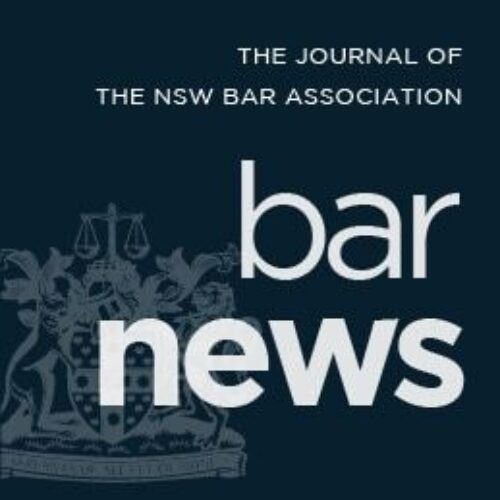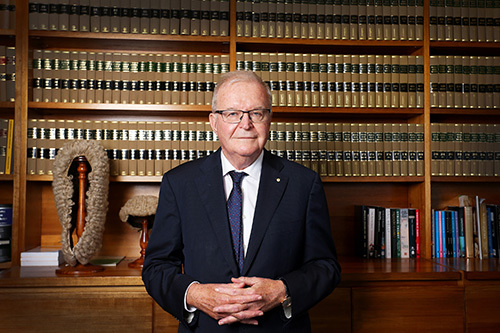
It was my incredibly good fortune to come to work for Chief Justice Bathurst shortly after his appointment in 2011. In the brief window between announcement and appointment, there wasn’t time to assemble the usual over-achieving pool of applicants, and I found myself with an interview my CV wouldn’t ordinarily have earned. Lacking legal pedigree and suspicious of the legal elite, I was dismayed by how much I enjoyed meeting him. He radiated calm good humour (his fricative chuckle would make Sesame Street’s Ernie proud) and seemed in possession of an excellent sense for mischief. ‘Shoot’, I thought. Now I really wanted the job I was sure I wouldn’t get. Happily, I was right about his temperament, wrong about my prospects, and pinched myself daily for the next 18 months.
Others have and will continue to reflect on Bathurst CJ’s time as head of our judiciary and profession by reference to his outstanding public leadership, contribution to legal precedent, and policy achievements. I wanted, here, to share a few of the more private aspects of his time in office that I think say as much, if not more, about the measure of the man.
I hope the indiscretion will be forgiven.
***
The chief justice approached the beginning of his judicial career as an adventure we – he and his staff – were on together.
He disliked being faffed over by eager tippies trying to do the menial things for him – gathering authorities, pushing the trolley across Queen Square, laying out robes. He compared our ministrations to the nursing staff of an old folks’ home. (I can’t say this made that part of our jobs easier.) Instead, he was interested in what we thought about the cases and arguments we had heard that day. He made time and space for us to learn by allowing us to tackle complex legal questions or speech topics, even though it meant taking more time to revise and give us feedback than it would have had he just done it himself. We learned a tremendous amount by osmosis, but he also took active mentorship seriously.
The chief also set the tone for a collegial court and profession from the outset of his tenure, hosting regular gatherings of judges, barristers, and court staff, in the rooms and garden of St James Road. He was deliberate about wanting to maintain what he considered the best aspects of life at the Bar – collegiality, mentorship and fun. His default was to be inclusive. He welcomed his and the staff of other chambers to social functions with judges and the profession in a way that made it clear we should be comfortable occupying that space. Writing now, in a time when such things do need to be said and thought about, I appreciate all the more how he created a space for us that was safe and comfortable, without being stuffy or soulless.
While always able to summon the sincerity or gravity demanded of a justice- in-chief, he also delighted in some of the attendant absurdities.
The commencement of law term has long been marked by the judges of the NSW courts trapsing across Queen Square in full ceremonial dress in 40-degree heat to attend various religious ceremonies.
His Honour prized many things over the black and white of the CV. He wanted his chambers to reflect a diversity of experiences and backgrounds
As someone with a self-confessed soft spot for ritual and regalia, even I can accept that this is, objectively, very silly. The mornings-of were almost always stressful for all involved; new tipstaves dashing about frantically with Santa suits or forgotten wigs, judges looking for the assembly points and jostling themselves into the order of seniority.
The chief justice could withstand the rush, the heat, the press of photographers who – for some reason – find the annual spectacle riveting, and the burden of solemnity amidst it all. But that he had to do all this while being led around by a frock-coated kid bearing an actual tipstaff – the symbolic ‘rod of justice’ – seemed to be his limit. It was my job to lead a number of those archaic processions, bearing the eponymous staff. As the only person who could hear the jokes and quips being muttered behind me from his somehow unmoving lips (never within an actual religious sanctum, mind), it was all but impossible to do with a straight face.
When it came time to hire his next round of staff, he included his current staff, and particularly those who would overlap with the new recruits, in the decision-making. This is where his Honour’s values were made plain. The quality of applicants was dizzying. But his Honour prized many things over the black and white of the CV. He wanted his chambers to reflect a diversity of experiences and backgrounds. He wasn’t looking to tick boxes, but instinctively recognised that diversity is strength. He was interested in future potential more than past achievement. What he wanted to know most was, would this person get along with the current team? Not take themselves too seriously? Bring in a fresh perspective? Be irreverent enough to write self-effacing jokes for their own boss (one of the absolute hardest parts of the job)? Any whiff of pretension or arrogance was the death knell of an applicant, no matter how stellar they appeared on paper.
The Chief’s many former researchers are now scattered far and wide. He goes out of his way to maintain contact with each of us, and us with him. He and Robyn detour their travels to visit former staff in their new homes or universities abroad. Four of us are also pursuing careers at the Bar as a direct result of his support and encouragement in chambers.
He convinced me to hang out my shingle directly, breaking through my hesitations around joining the legal fraternity – born of a sense of otherness and imposter syndrome – by convincing me, again, that diversity is both my, and its, strength. This is not to say that he operated under any illusions as to the overwhelming straight-white-male-ness of the place. To the contrary. But he believed it could be better and would be made better by more otherness.
I share these slightly more private reflections because, amidst all the celebrations and (entirely justified) lauding of the more obvious achievements of his career and contributions to the law and profession, I don’t want it to be lost that he did all that while being, at the same time, just a really great person. His contributions to the Bench and the Bar have made it a better place, not just in the big ways, but in little ways that, for many of us, can matter even more. BN

ENDNOTES
1 If you want to make our outgoing chief justice uncomfortable, give him praise. If you want to make the author uncomfortable, ask her to be earnest in public. So, for the record, chief justice, this is going to be painful for both of us. Also, there will be adjectives.
